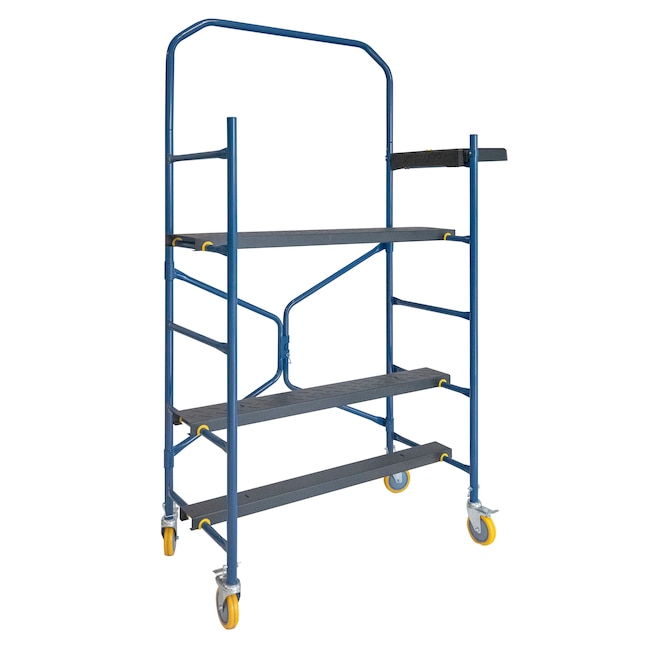Exploring the Various Sorts Of Scaffolding Made Use Of in Building And Construction Jobs
The building industry counts heavily on different types of scaffolding to satisfy certain task demands, each offering distinctive advantages and applications. Standard frame scaffolding provides a durable foundation for basic tasks, while put on hold scaffolding is necessary for work on high-rise structures.

Standard Framework Scaffolding
Typical framework scaffolding is one of one of the most extensively used approaches in the construction market because of its toughness and adaptability. This system contains straight and vertical frameworks that are assembled to produce a steady platform for materials and workers. The primary elements include vertical messages, straight ledgers, and angled dental braces, which with each other supply a strong framework that can sustain considerable loads.
Among the key advantages of standard framework scaffolding is its adaptability to numerous building and construction tasks, ranging from domestic buildings to huge commercial frameworks. The modular style permits very easy setting up and disassembly, making it effective for both long-term and short-term projects. In addition, the system can be personalized in elevation and size, fitting different structure styles and site problems.
Safety and security is vital in scaffolding applications, and standard frame systems are geared up with guardrails and toe boards to stop falls and make certain employee protection. Furthermore, routine assessments and adherence to safety and security guidelines are crucial in preserving the honesty of the scaffold. On the whole, traditional structure scaffolding stays an essential option in the construction industry, providing a reputable platform for labor and improving overall project efficiency

Suspended Scaffolding
Put on hold scaffolding provides an one-of-a-kind service for building and construction jobs that call for access to elevated surfaces, specifically in scenarios where standard frame scaffolding may be impractical. This sort of scaffolding is normally suspended from the roof or upper degrees of a framework, using a system of pulleys, ropes, and systems to produce a functioning space that can be changed to various elevations.
Among the main advantages of suspended scaffolding is its adaptability. It can be conveniently repositioned or reduced to suit changes in building demands, making it ideal for tasks such as home window setup, frontage job, and maintenance on skyscrapers. In addition, the minimal impact of suspended scaffolding enables better usage of ground space in urban atmospheres, where room is usually limited.
Security is a crucial factor to consider in the usage of put on hold scaffolding. Correct rigging and securing systems need to be used to ensure stability and protect against accidents. Operators must also be learnt the secure use this devices. Overall, suspended scaffolding provides a efficient and reliable option for accessing hard-to-reach locations in different construction scenarios, enhancing both productivity and safety and security on site.
System Scaffolding
System scaffolding, frequently considered a modern-day remedy in the scaffolding industry, is composed of pre-engineered parts that can be swiftly set up and adjusted for various building and construction jobs. Scaffolding. This sort of scaffolding is identified by its modular style, which enables for convenience and efficiency on job websites, accommodating structural needs and scaffolding hiring various elevations
Typically made from high-strength steel or aluminum, system scaffolding provides improved resilience and stability. The parts include vertical messages, straight ledgers, and diagonal dental braces, which adjoin firmly, ensuring a robust structure. The you can look here design commonly integrates standard fittings, simplifying assembly and disassembly procedures, therefore decreasing labor time and expenses.

Rolling Scaffolding
Rolling scaffolding is a flexible choice to traditional fixed scaffolding, created for movement and simplicity of usage on building and construction sites. This type of scaffolding includes a system sustained by frames with wheels, allowing workers to easily move it as required. The flexibility attribute significantly enhances efficiency, as it lessens downtime connected with taking apart and putting together repaired scaffolding.
Commonly constructed from light-weight products such as light weight aluminum or steel, rolling scaffolding offers a sturdy yet portable service for tasks requiring frequent repositioning - Scaffolding. It is specifically beneficial in jobs such as paint, drywall installment, and electrical job, where accessibility to numerous heights and locations is necessary
Security is paramount in rolling scaffolding design, with functions such as locking wheels to avoid unintentional movement when in operation, and guardrails to secure workers from drops. In addition, numerous models are flexible in height, fitting different project demands.
Cantilever Scaffolding

The design of cantilever scaffolding usually involves making use of brackets or arms anchored to a structure or framework, allowing the platform to expand external securely. Security is critical; hence, these scaffolds original site need to be crafted to hold up against different loads and environmental problems. Normal assessment and maintenance are vital to make sure structural integrity and employee safety and security.
Cantilever scaffolding is preferred for its versatility and effective use space, making it a popular option in metropolitan environments where room restrictions are usual. It facilitates easier accessibility to high altitudes, eventually adding to the general efficiency of building jobs. Just like all scaffolding kinds, proper training and adherence to security requirements are critical for workers using cantilever scaffolding.
Final Thought
Standard frame scaffolding supplies stability, while put on hold scaffolding supplies adaptability for raised tasks. System scaffolding promotes fast setting up, and rolling scaffolding improves movement for differing work settings.
Typical framework scaffolding provides a strong structure for basic tasks, while suspended scaffolding is vital for job on skyscraper structures.Rolling scaffolding is a versatile choice to typical fixed scaffolding, created for wheelchair and simplicity of use on building and construction sites. As with all scaffolding kinds, appropriate training and adherence to safety and security requirements are vital for workers utilizing cantilever scaffolding.
Traditional framework scaffolding supplies security, while put on hold scaffolding provides versatility for raised jobs. System scaffolding helps with quick assembly, and rolling scaffolding improves flexibility for differing job settings.